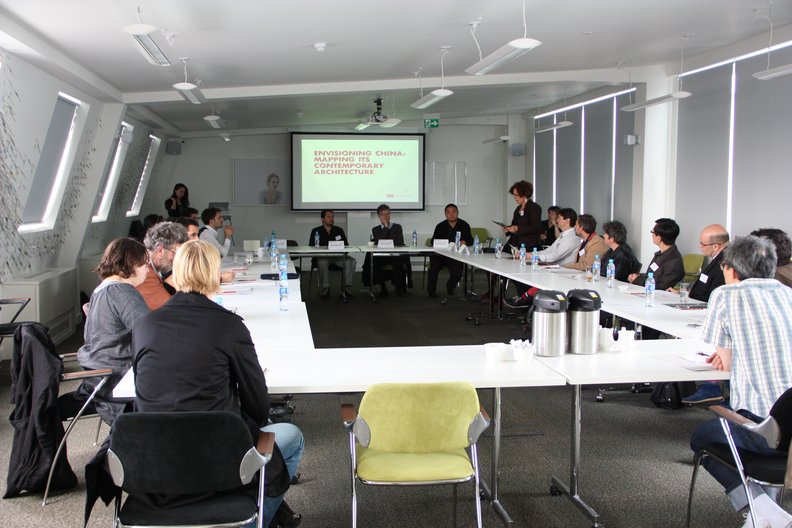
Symposium presentation. Image courtesy Sabrina Minqing Ni
13 July 2011
by Liz Farrelly
Liz Farrelly attended the recent Envisioning Chinese Architecture: Paradigms and Challenges Symposium held at Central Saint Martins a few weeks back. Here Liz shares some of the conversation from the day:
Sparked by a project teaming staff and students of MA Creative Practice for Narrative Environments (CPNE) with the Shanghai Contemporary Architectural Culture Centre (SCACC), this Symposium brought together Chinese and European architects and academics to discuss current, past and future crossovers between East and West as manifest in China’s built environment.
Proceedings commenced with Sabrina Minqing Ni, of CSM, discussing the project with SCACC. 24 keywords were identified and assigned to Chinese and international architects, as inspiration for each to design a piece of furniture, creating the bedrock of the new centre’s permanent collection.
The question, “What is Chineseness?” was tackled by Xiangning Li, Founding Director of SCACC and Associate Professor at Tongji University, (and replied to by subsequent speakers). He presented examples of contemporary Chinese architecture referencing traditional elements; using local materials (brick) and vernacular forms (the courtyard), but often playfully subverting traditional use and meaning, and getting away with it. He also suggested key words to describe new building in China; Novelty, Monumentality, Bigness, Swiftness, Cheapness, and that another set of evaluation models are needed (not Western norms), as Chinese architecture comes from a different “starting point”.
Two practicing architects, Mark Randel of David Chipperfield Architects, and Peter Barbalov of Terry Farrell and Partners, both with multiple projects in China, offered valuable insight into working there, and spelt out some issues. Pragmatism is the order of the day; “be adaptive”; “get to know the country”. Establishing a personal relationship with a client will often parlay small beginnings into mega-projects. And, research what’s available; using local materials (which are affordable and plentiful, as opposed to spec-ing prohibitively priced imports) may prompt interesting design solutions; in China stone is cheaper than concrete!
Adrian Forty, Professor of Architectural History at the Bartlett, offered “some observations”. He reminded us that architecture is unlike other art practices in that it is not a “single medium”, and that along with any built iteration, photography, exhibitions, digital media and words, working in conjunction, constitute the practice of architecture. Architecture, as a recognised profession, is only a century old in China, and based on a western model; however, the language needed to discuss, critique and explain architecture has not translated into Chinese practice. Instead, language is borrowed from western discourse, and that creates a problem, “a struggle, a challenge”.
Forty also suggested that because of China’s isolation and centuries of cultural self-sufficiency, the idea of “Chineseness” has only recently been constructed, and is the result of external relations. Thinking about what constitutes national characteristics was initially promoted in relation to other cultures (Japan, Europe, the USA). It is in effect, the creation of a “boundary”. Ironically, “Chineseness” must represent a great tradition; but that process of representation is itself less than a century old.
While the architects stressed the need to remember, “Shanghai isn’t the whole country”, the issue of regional and ethnic differences was raised; and how that might alter any idea of “Chineseness”. Xiangning Li suggested that the urge to modernise was just as strong in rural communities as in cities, and that ideally, those populations should be able to choose, not simply be told, what to build. He also reminded us that the Cultural Revolution broke the “connection with the past”; literature was destroyed, universities were closed. That period in China’s history is now being acknowledged and investigated, and, he suggests, a new, contemporary version of tradition will result.
Xiangning Li also mentioned what he called, “Critical Pragmatism”. There are emerging voices in China, he stressed, discussing critical discourse. “But most Chinese architects are too busy building. When the economy slows down it may happen more…”
Indeed. Without “Paper Architecture” (those un-built experiments created before an architect gets commissioned and “busy”) critical discourse and the subsequent history of the built environment in the west would be seriously different. That “autonomy”, that space to think, without the pressure of a client and a commission, is a luxury Chinese architects don’t have; for the time being. Having said that, from the evidence put forward by the speakers, those western architects who are happy to forgo (unpaid) autonomy, and work in China (for as long as what Barbalov termed “the gold rush” continues), have managed to adapt their practice for Chinese clients; they call it being pragmatic. Reconvening in a year to two, to re-evaluate such a constantly evolving landscape/cityscape, may help us judge the effectiveness of such an approach.